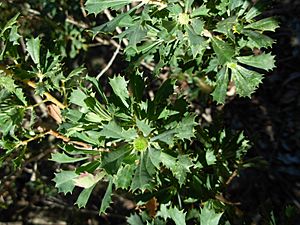Banksia sessilis var. cygnorum facts for kids
Quick facts for kids Banksia sessilis var. cygnorum |
|
|---|---|
 |
|
| Scientific classification |
|
| Kingdom: | Plantae |
| Clade: | Tracheophytes |
| Clade: | Angiosperms |
| Clade: | Eudicots |
| Order: | Proteales |
| Family: | Proteaceae |
| Genus: | Banksia |
| Species: | |
| Varietas: |
B. s. var. cygnorum
|
| Trinomial name | |
| Banksia sessilis var. cygnorum (Gand.) A.R.Mast & K.R.Thiele
|
|
| Synonyms | |
|
Dryandra quinquedentata Gand. Dryandra cygnorum Gand. |
|
Banksia sessilis var. cygnorum is a special type, or variety, of the plant known as Parrot Bush (Banksia sessilis). It's a unique plant found in Western Australia.
Contents
What It Looks Like
This plant grows as a shrub and can reach up to five metres (about 16 feet) tall. Its stems are covered with soft, fine hairs.
Leaves
This variety has the smallest leaves of all Banksia sessilis types. They are usually no longer than three centimetres (about 1.2 inches). They are also less than two centimetres (about 0.8 inches) wide. The leaves often look like a wedge. They have a long, smooth bottom edge without any teeth. They are similar to the leaves of B. sessilis var. flabellifolia. However, they are a bit smaller. Their bottom edge is curved inwards. Sometimes, they have small bumps at the base. The leaves are often a much darker green colour.
Flowers
Like other types of Banksia sessilis, its flowers are greenish-yellow. Each flower head has between 55 and 65 individual flowers.
How It Got Its Name
This plant variety was first described in 1919 by a scientist named Michel Gandoger. He actually gave it two different names at first. One name was Dryandra quinquedentata. The other was Dryandra cygnorum.
Why the Name Changed
In 1996, another scientist, Alex George, looked at Gandoger's work. He realized that both names were for the same plant. Gandoger had only separated them by small differences. These included leaf width, number of leaf teeth, and flower head length. But these features can change a lot within this one plant type. So, George decided to use the name cygnorum. He made it a variety of Dryandra sessilis.
The word cygnorum likely comes from the Latin word for "swan." This is probably because the plant was first found near the Swan River.
Its Current Name
In 2007, scientists Austin Mast and Kevin Thiele made a big change. They moved all Dryandra plants into the Banksia group. Because of this, the plant's full scientific name today is Banksia sessilis var. cygnorum (Gand.) A.R.Mast & K.R.Thiele.
Where It Grows
Banksia sessilis var. cygnorum is found along the coast of Western Australia. You can see it from Dongara in the north. It grows south of Fremantle. It mostly lives near the coast in sand that sits over limestone. However, it can also be found further inland. For example, it grows in Kings Park and around Lake Indoon.
Growing This Plant
This plant variety is not very common in gardens. People think it needs similar care to the more well-known Banksia sessilis var. sessilis. Even though it's a coastal plant, it can handle cold weather. It has been reported to survive temperatures as low as -7°C (19°F).


